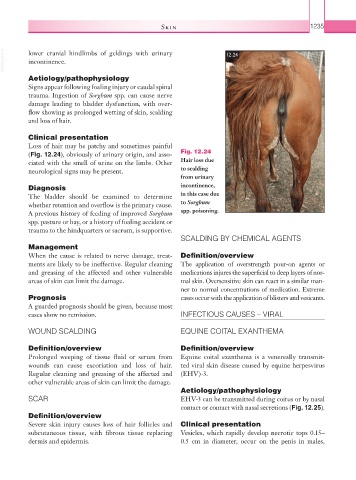Page 1260 - Equine Clinical Medicine, Surgery and Reproduction, 2nd Edition
P. 1260
Skin 1235
VetBooks.ir lower cranial hindlimbs of geldings with urinary 12.24
incontinence.
Aetiology/pathophysiology
Signs appear following foaling injury or caudal spinal
trauma. Ingestion of Sorghum spp. can cause nerve
damage leading to bladder dysfunction, with over-
flow showing as prolonged wetting of skin, scalding
and loss of hair.
Clinical presentation
Loss of hair may be patchy and sometimes painful
(Fig. 12.24), obviously of urinary origin, and asso- Fig. 12.24
ciated with the smell of urine on the limbs. Other Hair loss due
neurological signs may be present. to scalding
from urinary
Diagnosis incontinence,
The bladder should be examined to determine in this case due
whether retention and overflow is the primary cause. to Sorghum
A previous history of feeding of improved Sorghum spp. poisoning.
spp. pasture or hay, or a history of foaling accident or
trauma to the hindquarters or sacrum, is supportive.
SCALDING BY CHEMICAL AGENTS
Management
When the cause is related to nerve damage, treat- Definition/overview
ments are likely to be ineffective. Regular cleaning The application of overstrength pour-on agents or
and greasing of the affected and other vulnerable medications injures the superficial to deep layers of nor-
areas of skin can limit the damage. mal skin. Oversensitive skin can react in a similar man-
ner to normal concentrations of medication. Extreme
Prognosis cases occur with the application of blisters and vesicants.
A guarded prognosis should be given, because most
cases show no remission. INFECTIOUS CAUSES – VIRAL
WOUND SCALDING EQUINE COITAL EXANTHEMA
Definition/overview Definition/overview
Prolonged weeping of tissue fluid or serum from Equine coital exanthema is a venereally transmit-
wounds can cause excoriation and loss of hair. ted viral skin disease caused by equine herpesvirus
Regular cleaning and greasing of the affected and (EHV)-3.
other vulnerable areas of skin can limit the damage.
Aetiology/pathophysiology
SCAR EHV-3 can be transmitted during coitus or by nasal
contact or contact with nasal secretions (Fig. 12.25).
Definition/overview
Severe skin injury causes loss of hair follicles and Clinical presentation
subcutaneous tissue, with fibrous tissue replacing Vesicles, which rapidly develop necrotic tops 0.15–
dermis and epidermis. 0.5 cm in diameter, occur on the penis in males,

